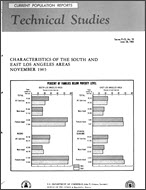Characteristics of the South and East Los Angeles Areas: November 1965
Characteristics of the South and East Los Angeles Areas: November 1965
Introduction
This report presents the results of a special census of designated southern and eastern portions of Los Angeles taken as of November 15, 1965. The census was recommended by the President's Task Force appointed to investigate the disturbances in Watts and adjoining areas of Los Angeles in the summer of 1965 and was extended to additional areas in East Los Angeles at the request of local welfare and planning groups. The survey was financed by the Office of Economic Opportunity and conducted by the Bureau of the Census.
The areas enumerated include (a) the South Los Angeles area, an irregular area of about 2,552 blocks and 320,000 inhabitants, bounded roughly by Adams Boulevard on the north, Rosecrans on the south, Alameda on the east, and Crenshaw, Arlington, and Vermont on the west; and (b) the East Los Angeles area with a population of about 180,000 including the unincorporated area of East Los Angeles together with the area lying between East Los Angeles and Alameda Avenue and extending north as far as North Broadway. (See map.) The population of South Los Angeles is predominantly Negro and that of East Los Angeles predominantly Mexican-American.
Information is presented on both population and housing characteristics. The population items are: Race and color, nativity and parentage, foreign stock and country of origin, age, relationship to head of household, marital status, married couples and families, school enrollment, years of school completed, residence in 1960, income for the preceding 12 months, poverty level, employment status, occupation, industry, class of worker, place of work, and means of transportation to work. The housing items are: Tenure of housing unit, color of occupants, vacancy status, number of persons in the unit, persons per room, number of units in structure, year structure built, year moved into unit, number of rooms, condition and plumbing, number of bathrooms, heating equipment, automobiles available, value of property, contract rent, and gross rent. The tables also include comparable statistics from the 1960 Census on each of these subjects.
The 1965 statistics are based on a 10-percent sample of housing units scientifically selected from a complete list of mailing addresses compiled by census workers who canvassed the entire census area. The enumeration procedure was a combination of self-enumeration and direct interview. Household Questionnaires containing most of the same questions that had been asked in the 1960 Census were mailed to each household included in the sample, to be filled out by members of the household. Census enumerators later visited the selected households to pick up the questionnaires and complete any information that was lacking. Most of the 1960 Census data shown in the report are based on a 25-percent sample. (See section on "Sample design and sampling variability" for more detail on sampling rates.)
A Note on Language
Census statistics date back to 1790 and reflect the growth and change of the United States. Past census reports contain some terms that today’s readers may consider obsolete and inappropriate. As part of our goal to be open and transparent with the public, we are improving access to all Census Bureau original publications and statistics, which serve as a guide to the nation's history.
Others in Series
Publication
Publication
Publication






